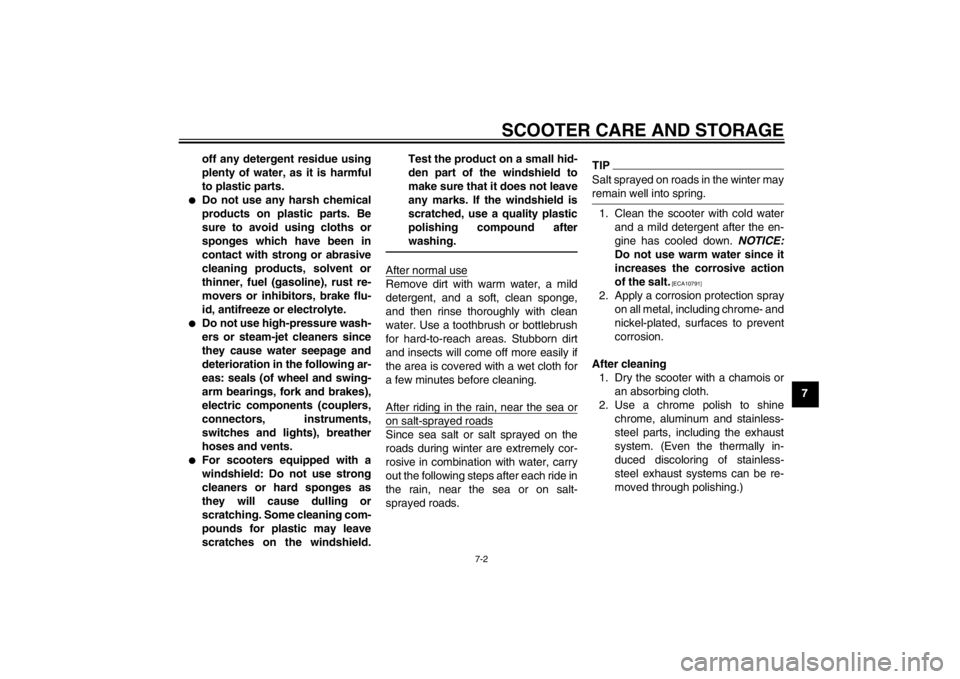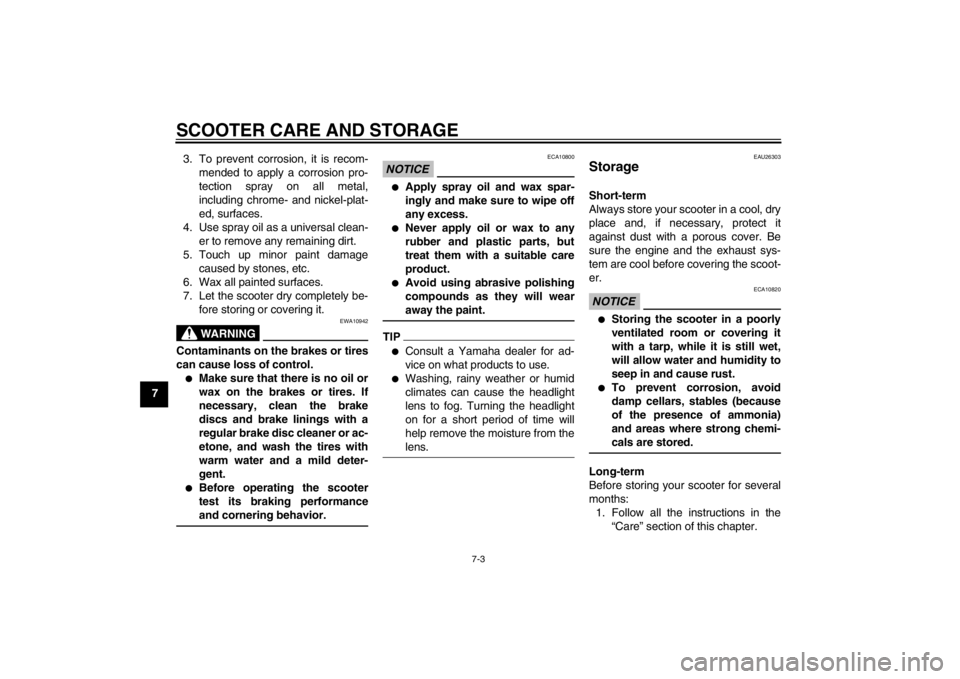light YAMAHA CYGNUS L 2012 Owner's Manual
[x] Cancel search | Manufacturer: YAMAHA, Model Year: 2012, Model line: CYGNUS L, Model: YAMAHA CYGNUS L 2012Pages: 76, PDF Size: 1.56 MB
Page 66 of 76

SCOOTER CARE AND STORAGE
7-1
7
EAU37833
Matte color caution NOTICE
ECA15192
Some models are equipped with
matte colored finished parts. Be
sure to consult a Yamaha dealer for
advice on what products to use be-
fore cleaning the vehicle. Using a
brush, harsh chemical products or
cleaning compounds when cleaning
these parts will scratch or damage
their surface. Wax also should not
be applied to any matte colored fin-
ished parts.
EAU26094
Care While the open design of a scooter re-
veals the attractiveness of the technol-
ogy, it also makes it more vulnerable.
Rust and corrosion can develop even if
high-quality components are used. A
rusty exhaust pipe may go unnoticed
on a car, however, it detracts from the
overall appearance of a scooter. Fre-
quent and proper care does not only
comply with the terms of the warranty,
but it will also keep your scooter looking
good, extend its life and optimize its
performance.
Before cleaning
1. Cover the muffler outlet with a
plastic bag after the engine has
cooled down.
2. Make sure that all caps and covers
as well as all electrical couplers
and connectors, including the
spark plug cap, are tightly in-
stalled.
3. Remove extremely stubborn dirt,
like oil burnt onto the crankcase,
with a degreasing agent and a
brush, but never apply such prod-ucts onto seals, gaskets and wheel
axles. Always rinse the dirt and de-
greaser off with water.
Cleaning
NOTICE
ECA10783
●
Avoid using strong acidic wheel
cleaners, especially on spoked
wheels. If such products are
used on hard-to-remove dirt, do
not leave the cleaner on the af-
fected area any longer than in-
structed. Also, thoroughly rinse
the area off with water, immedi-
ately dry it, and then apply a cor-
rosion protection spray.
●
Improper cleaning can damage
plastic parts (such as cowlings,
panels, windshields, headlight
lenses, meter lenses, etc.) and
the mufflers. Use only a soft,
clean cloth or sponge with wa-
ter to clean plastic. However, if
the plastic parts cannot be thor-
oughly cleaned with water, di-
luted mild detergent with water
may be used. Be sure to rinse
U1RSE0E0.book Page 1 Tuesday, October 18, 2011 8:56 AM
Page 67 of 76

SCOOTER CARE AND STORAGE
7-2
7 off any detergent residue using
plenty of water, as it is harmful
to plastic parts.
●
Do not use any harsh chemical
products on plastic parts. Be
sure to avoid using cloths or
sponges which have been in
contact with strong or abrasive
cleaning products, solvent or
thinner, fuel (gasoline), rust re-
movers or inhibitors, brake flu-
id, antifreeze or electrolyte.
●
Do not use high-pressure wash-
ers or steam-jet cleaners since
they cause water seepage and
deterioration in the following ar-
eas: seals (of wheel and swing-
arm bearings, fork and brakes),
electric components (couplers,
connectors, instruments,
switches and lights), breather
hoses and vents.
●
For scooters equipped with a
windshield: Do not use strong
cleaners or hard sponges as
they will cause dulling or
scratching. Some cleaning com-
pounds for plastic may leave
scratches on the windshield.Test the product on a small hid-
den part of the windshield to
make sure that it does not leave
any marks. If the windshield is
scratched, use a quality plastic
polishing compound after
washing.
After normal useRemove dirt with warm water, a mild
detergent, and a soft, clean sponge,
and then rinse thoroughly with clean
water. Use a toothbrush or bottlebrush
for hard-to-reach areas. Stubborn dirt
and insects will come off more easily if
the area is covered with a wet cloth for
a few minutes before cleaning.
After riding in the rain, near the sea oron salt-sprayed roadsSince sea salt or salt sprayed on the
roads during winter are extremely cor-
rosive in combination with water, carry
out the following steps after each ride in
the rain, near the sea or on salt-
sprayed roads.
TIPSalt sprayed on roads in the winter may
remain well into spring.1. Clean the scooter with cold water
and a mild detergent after the en-
gine has cooled down. NOTICE:
Do not use warm water since it
increases the corrosive action
of the salt.
[ECA10791]
2. Apply a corrosion protection spray
on all metal, including chrome- and
nickel-plated, surfaces to prevent
corrosion.
After cleaning
1. Dry the scooter with a chamois or
an absorbing cloth.
2. Use a chrome polish to shine
chrome, aluminum and stainless-
steel parts, including the exhaust
system. (Even the thermally in-
duced discoloring of stainless-
steel exhaust systems can be re-
moved through polishing.)
U1RSE0E0.book Page 2 Tuesday, October 18, 2011 8:56 AM
Page 68 of 76

SCOOTER CARE AND STORAGE
7-3
73. To prevent corrosion, it is recom-
mended to apply a corrosion pro-
tection spray on all metal,
including chrome- and nickel-plat-
ed, surfaces.
4. Use spray oil as a universal clean-
er to remove any remaining dirt.
5. Touch up minor paint damage
caused by stones, etc.
6. Wax all painted surfaces.
7. Let the scooter dry completely be-
fore storing or covering it.
WARNING
EWA10942
Contaminants on the brakes or tires
can cause loss of control.●
Make sure that there is no oil or
wax on the brakes or tires. If
necessary, clean the brake
discs and brake linings with a
regular brake disc cleaner or ac-
etone, and wash the tires with
warm water and a mild deter-
gent.
●
Before operating the scooter
test its braking performance
and cornering behavior.
NOTICE
ECA10800
●
Apply spray oil and wax spar-
ingly and make sure to wipe off
any excess.
●
Never apply oil or wax to any
rubber and plastic parts, but
treat them with a suitable care
product.
●
Avoid using abrasive polishing
compounds as they will wear
away the paint.
TIP●
Consult a Yamaha dealer for ad-
vice on what products to use.
●
Washing, rainy weather or humid
climates can cause the headlight
lens to fog. Turning the headlight
on for a short period of time will
help remove the moisture from the
lens.
EAU26303
Storage Short-term
Always store your scooter in a cool, dry
place and, if necessary, protect it
against dust with a porous cover. Be
sure the engine and the exhaust sys-
tem are cool before covering the scoot-
er.NOTICE
ECA10820
●
Storing the scooter in a poorly
ventilated room or covering it
with a tarp, while it is still wet,
will allow water and humidity to
seep in and cause rust.
●
To prevent corrosion, avoid
damp cellars, stables (because
of the presence of ammonia)
and areas where strong chemi-
cals are stored.
Long-term
Before storing your scooter for several
months:
1. Follow all the instructions in the
“Care” section of this chapter.
U1RSE0E0.book Page 3 Tuesday, October 18, 2011 8:56 AM
Page 71 of 76

SPECIFICATIONS
8-2
8
Front tire:Type:
Tubeless
Size:
100/90-10 56J
Manufacturer/model:
CHENG SHIN/C-922-XRear tire:Type:
Tubeless
Size:
100/90-10 56J
Manufacturer/model:
CHENG SHIN/C-940-XLoading:Maximum load:
165 kg (364 lb)
(Total weight of rider, passenger, cargo and
accessories)Tire air pressure (measured on cold
tires):Loading condition:
0–75 kg (0–165 lb)
Front:
175 kPa (1.75 kgf/cm², 25 psi)
Rear:
250 kPa (2.50 kgf/cm², 36 psi)
Loading condition:
75–153 kg (165–337 lb)
Front:
175 kPa (1.75 kgf/cm², 25 psi)
Rear:
250 kPa (2.50 kgf/cm², 36 psi)
Front wheel:Wheel type:
Cast wheel
Rim size:
J10 x MT2.15Rear wheel:Wheel type:
Cast wheel
Rim size:
J10 x MT2.50Front brake:Type:
Single disc brake
Operation:
Right hand operation
Specified brake fluid:
DOT 3 or 4Rear brake:Type:
Drum brake
Operation:
Left hand operationFront suspension:Type:
Telescopic fork
Spring/shock absorber type:
Coil spring/oil damper
Wheel travel:
80.0 mm (3.15 in)Rear suspension:Type:
Unit swing
Spring/shock absorber type:
Coil spring/oil damperWheel travel:
63.0 mm (2.48 in)
Electrical system:Ignition system:
DC CDI
Charging system:
AC magnetoBattery:Model:
YTX7A-BS
Voltage, capacity:
12 V, 6.0 AhHeadlight:Bulb type:
IncandescenceBulb voltage, wattage × quantity:Headlight:
12 V, 35 W/35 W × 1
Tail/brake light:
12 V, 5.0 W/21.0 W × 1
Front turn signal light:
12 V, 10.0 W × 2
Rear turn signal light:
12 V, 16.0 W × 2
Auxiliary light:
12 V, 3.0 W × 1
Meter lighting:
12 V, 3.4 W × 2
High beam indicator light:
12 V, 1.7 W × 1
Turn signal indicator light:
12 V, 1.7 W × 1
Engine trouble warning light:
12 V, 3.4 W × 1
U1RSE0E0.book Page 2 Tuesday, October 18, 2011 8:56 AM
Page 74 of 76

INDEXAAcceleration and deceleration................. 5-2
Air filter and V-belt case air filter
elements ............................................. 6-13
Auxiliary light bulb, replacing ................ 6-28BBattery................................................... 6-24
Brake fluid, changing ............................ 6-21
Brake fluid level, checking .................... 6-20
Brake lever, front..................................... 3-5
Brake lever, rear ..................................... 3-5
Brake levers, lubricating........................ 6-22
Brake pads and shoes, checking .......... 6-19
Braking .................................................... 5-2CCables, checking and lubricating .......... 6-21
Care ........................................................ 7-1
Carrier ................................................... 3-11
Catalytic converters ................................ 3-7
Centerstand and sidestand,
checking and lubricating ..................... 6-22
Cowlings and panels,
removing and installing ......................... 6-7DDimmer switch ........................................ 3-4EEngine break-in ....................................... 5-3
Engine idling speed, checking .............. 6-15
Engine oil .............................................. 6-10
Engine serial number .............................. 9-1
Engine trouble warning light.................... 3-3FFinal transmission oil ............................ 6-12
Frame serial number ............................... 9-1Front brake lever free play, checking ... 6-18
Front fork, checking .............................. 6-23
Fuel......................................................... 3-6
Fuel consumption, tips for reducing........ 5-3
Fuel gauge.............................................. 3-4
Fuel tank cap .......................................... 3-5
Fuse, replacing ..................................... 6-26
GGrab bar ............................................... 3-11HHandlebar switches ................................ 3-4
Headlight bulb, replacing ...................... 6-26
Helmet holders ....................................... 3-9
High beam indicator light ........................ 3-2
Horn switch ............................................. 3-4IIdentification numbers ............................ 9-1
Ignition circuit cut-off system ................ 3-12
Indicator lights and warning light ............ 3-2KKeyhole cover ......................................... 3-2
Kickstarter............................................... 3-8LLuggage hook ....................................... 3-11MMain switch/steering lock........................ 3-1
Maintenance and lubrication, periodic .... 6-4
Maintenance, emission control system... 6-3
Matte color, caution ................................ 7-1PParking ................................................... 5-4
Part locations .......................................... 2-1RRear brake lever free play, adjusting .... 6-18Rear turn signal light and
tail/brake light...................................... 6-28
SSafe-riding points .................................... 1-5
Safety information ................................... 1-1
Seat ......................................................... 3-8
Self-diagnosis device .............................. 3-3
Sidestand .............................................. 3-12
Spark plug, checking ............................... 6-9
Specifications .......................................... 8-1
Speedometer unit .................................... 3-3
Starting off ............................................... 5-2
Starting the engine .................................. 5-1
Start switch.............................................. 3-4
Steering, checking................................. 6-24
Storage.................................................... 7-3
Storage compartments ............................ 3-9TThrottle grip and cable,
checking and lubricating ..................... 6-21
Throttle grip free play, checking ............ 6-15
Tires ...................................................... 6-16
Troubleshooting .................................... 6-29
Troubleshooting chart ........................... 6-30
Turn signal indicator light ........................ 3-2
Turn signal light bulb (front),
replacing ............................................. 6-27
Turn signal switch ................................... 3-4VValve clearance..................................... 6-15WWheel bearings, checking ..................... 6-24
Wheels .................................................. 6-17
U1RSE0E0.book Page 1 Tuesday, October 18, 2011 8:56 AM